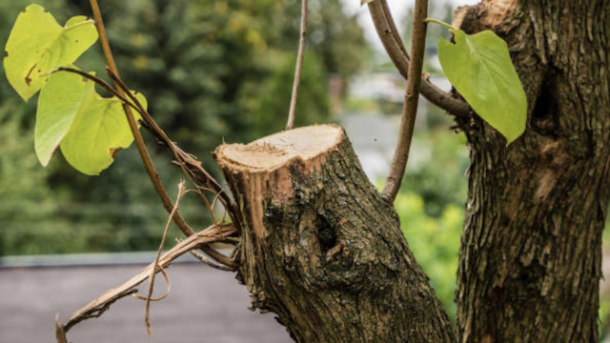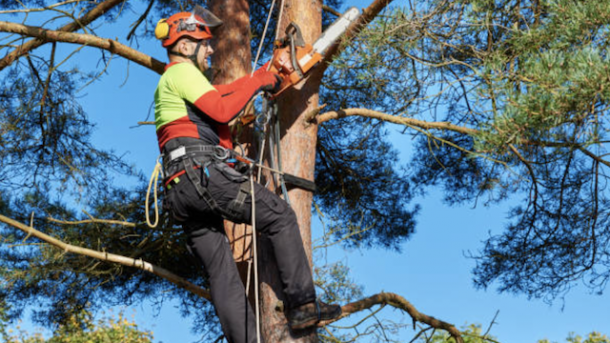Tree pruning is best left to experienced professionals. It’s a dangerous job, climbing trees, wielding chainsaws and dropping heavy branches to the ground; and it is sometimes dangerous for the tree as well. Trees that aren’t pruned correctly can experience a lifetime of damage.
Rather than putting yourself and the tree itself at risk, hire a professional who is trained and experienced to do the job for you.
This will lead to stronger trees and a safer environment around your house for several reasons:
- Healthier trees are sturdier and less likely to cause damage during severe storms
- Maintained trees won’t attract or spread parasites and diseases
- Trimmed trees produce more flowers or fruit
- Pruned trees offer shade while still allowing air to flow through their canopies and your property
IN Tree Trimming highly suggests trimming trees that are very close to your house or all that are a focus of your landscape.
Is Tree Trimming Necessary?
It is not required. But it is important. Trees are very hardy and survive on their own everywhere in the world, in a variety of different climates and regions, without being pruned.
However, there are many benefits of professional tree trimming, so it’s recommended for trees that you value. This can include sentimental trees, fruit trees and blossoming trees or trees that offer an important job for your house, such as shade or wildlife habitat.
Tree Pruning Gone Wrong
Pruning a tree is a complex project. You are going to need the right equipment and a lot of information to guarantee the project is done correctly. The vast majority of homeowners don’t have any of these!
But that’s alright, because there are many services out there who know exactly how to correctly prune trees for an affordable price to you including all arborists throughout Indiana we work with!
Below are the 5 most common mistakes people make when they attempt DIY tree trimming that can lead to many tree problems. These are things that a trained arborist from IN Tree Trimming will know, and that’s exactly why their services are worth paying for!
Pruning Too Much
When done properly, tree trimming is an ongoing process. Beginning when your trees are just 2 or 3 years old, they should be maintained by an arborist if you care about them and desire to keep them healthy.
A huge mistake that people often make when trimming trees by themselves is trimming too much of the tree all at once. This occurs because they have let the tree’s growth get out of hand and try to fix it all at once. Ideally, you should only cut off 5-20% of the tree’s crown at a time. It is much easier to do this during a season that there are no leaves, but a certified arborist is able to safely prune trees any time of year.
Removing Tree Bark
After you cut a tree limb and gravity starts to pull it down, it can rip bark from the tree trunk right along with it. This exposes the tree’s inner layers, leaving the tree in danger of attracting diseases and making it easier for pests and rodents to find their way in.
To guarantee this doesn’t happen, a trained arborist will make special cuts beneath larger branches before making their final removal cut. Knowing how to place these initial cuts takes pressure off the branch collar and reduces the stress at the exact point of the main cut so the branch doesn’t tear.
Trimming in the Wrong Place
An experienced tree specialist knows exactly where to cut each limb to protect against damage. This cut should be done just beyond the branch collar, the specific place where the branch connects to the tree trunk.
Cutting too close to the branch collar exposes the tree to insects, decay and mildew. Cutting too far away from it leaves a stump when the tree has recovered. Most DIY tree trimming leads to an improper cut, leaving either aesthetic or structural issues.
Pruning Large Branches
Branches any larger than 4 inches in diameter really shouldn’t be pruned unless it is absolutely necessary. Cutting off a branch this large can lead to imbalance in the tree and expose it to pests and rodents and decay as the tree recovers from losing such a big branch.
Conservative pruning once each year ensures that your tree trimmer only has to cut off branches that are 2-3 inches in diameter, which results in a more attractive shape for the tree and less risk of harming the tree or exposing it to disease and pests.
Topping the Tree
Tree topping is an outdated type of pruning, and for good reason! During this process, arborists would cut the top off of the tree to achieve the desired height. It was not attractive nor beneficial for the tree, so the majority of tree care companies do not practice tree topping currently.
During DIY tree pruning, you may think this is a good way to reduce the height of your tree with just a single cut, but once you have cut the top of a tree off, there’s virtually no chance that it will ever return to a natural shape.
The Solution? Call IN Tree Trimming
Let’s face it. Your tree may never recover from bad pruning.
Performing this job yourself might seem like a way to save a little money, but you could end up with way more cost trying to revive damaged trees, so it’s a lot safer (and more economical in the long run) to hire a certified arborist in Indiana from IN Tree Trimming.
Limbs aren’t going to grow back. The tree will grow more, but it will not grow back in the same places, which causes strange shapes that could take years to fix. The tree could end up looking bad for the rest of its life, all because of just one pruning error.
Improper pruning could also result in death of the tree. Cutting off too many branches (and, therefore, leaves) can inhibit the tree’s photosynthesis process, which means it won’t get all of the water it needs or enough sunlight and carbon dioxide to continue healthy growth.
Cutting off too many branches can also send the tree into a state of shock. Shock can be overcome, but it takes a great deal of patience and care. Even with proper care, a tree experiencing shock may still die.
Avoid all of these tree trimming mistakes and call IN Tree Trimming to speak with a tree care specialist in Indiana able to come up with a long-term plan to ensure your tree continues blossoming and looking beautiful for years to come!








